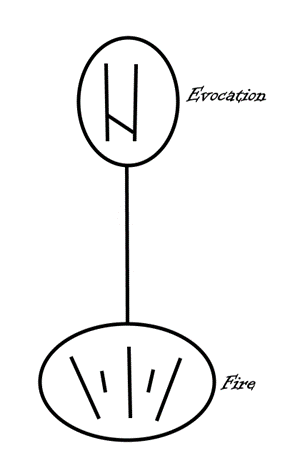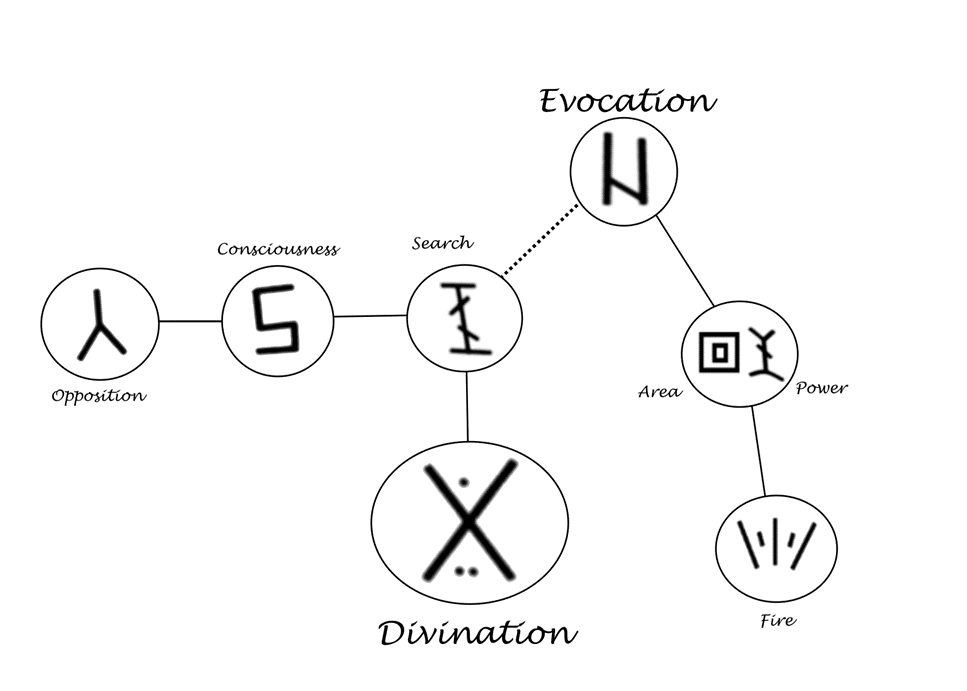Arcane Magic
Spells are created by arranging and connecting runes. Players are therefore able to create custom spells provided they can come up with a valid rune configuration for the spell. As spellcasters level up, they gain access to more runes and will gain knowledge of more stock spells. There are a large number of stock spells in game but custom spells are permitted to the GM’s discretion.
The most basic spells can be made out of a single primary rune and a single secondary rune. For example:

The image above shows an evocation rune connected to a fire rune. This creates the spell Evoke Fire, which will set a target on fire at a given success rate, depending on the skill level of the caster.
In this case, because there is no targetting rune, this will be performed as a touch attack.
Much more complex systems than this can be created, of course. As spellcasters learn more runes and players get better at creating spells from them, you can get spells like this one:

This will search for a valid target in range that is in opposition to the caster, and if one is found, it will then set it on fire. Note the violet line between the Target and Divination runes. These lines are referred to as “argument connectors” which in this case means that the target rune is taking that divination spell as an argument.
Also note that the search rune affects how Divination works as an argument for a target rune. Normally, Divination would check if the selected target meets the criteria. The spell would not cast if it did not. The search rune searches for a valid target. Specifics for how runes should work in different situations can be found on the rune's page. Normally, it is straightforward.
Overview
MP pool and power value
There are two things that can restrict a spellcaster in what they are able to cast:
- Their MP pool
- The power value of the spell
Each rune comes with a cost on both of these. In most cases, runes will cost 1MP and increase the PV of a spell by one when used in a spell.
A caster's maximum PV for a spell is determined by the primary rune of the spell. For example, if the primary rune is Evocation, your PV will be Calculating Arcana skill level + Evocation skill level + INT bonus + any misc bonuses (eg. from enchanted items). This is then checked against the PV cost of the spell. If a spell’s PV is higher than the caster’s PV, the caster cannot cast that spell.
For example, a character with level one Calculating Arcana, Level four Evocation, 16 INT and an item enchanted to give +1 PV for Evocation spells would have a total of 9 for their Evocation Maximum Power Value.
By attaching a power rune to the primary rune of the spell, a caster can spend extra MP to cast a spell which is outside of their normal capabilities. Doing this will increase the MP cost by 2, but decrease the PV by 1.
If two primary runes exist in a spell, ie. one spell chains into another, the caster must have sufficient MP to cast both spells. The PV of each spell is measured against the respective maximum PV of the caster in that school of magic. For example, consider the spell given as an example of a complex spell earlier:

The main spell here is an Evocation spell, using a Divination spell as an argument for a target rune.
The Evocation spell uses the runes target, fire and power. Target and fire will increase the MP and PV of the spell by 1. Power will increase the MP by 2 and PV by 1 when used to power up a rune like this. The total MP cost from the Evocation runes will be 4 and the total PV cost will be 3.
The Divination spell uses the runes search, consciousness and opposition. Each of which increase the MP and PV cost of the spell by 1. The total MP cost from the Divination runes will 3 and the PV cost will also be 3.
The MP cost of these is then totalled for the full MP cost, meaning the spell will cost 7MP to cast. However, in order to be skilled enough to cast the spell, the caster will only need to have the PV for each school's own respective PV. So in this case, the caster would need 4 maximum PV in evocation and 3 maximum PV in Divination.
In cases where the same primary rune appears more than once, the PV will be totalled for everything under that primary rune.

In this spell, two separate target runes are using Divination spells as arguments. The PV for both of the these Divination spells would be added together and that would be compared against the caster's maximum PV for Divination.
Note also the lack of a search rune on the Divination spell argument for the area rune. Each target rune handles arguments slightly differently and some runes, such as search, can work differently when used as an argument in different contexts.
Primary Runes
Primary runes are essentially schools of magic. The primary rune used will determine which skill is factored into rolls and the which verb runes can be used to create the spell. When you have points in a magic skill, you automatically have knowledge of the primary rune for that school and it does not take up a rune slot. The primary runes are:
Alteration

Alteration spells are usually positive effects given to the caster themselves or allies or negative effects given to an enemy.
Conjuration

Conjuration spells usually involve summoning energy or beings. Most runes can be used with conjuration, but their effects will apply to a creature/creatures being summoned in the same spell.
Divination

Divination spells are usually used to find information. A divination spell can be used as a more specific target selection for other spells and an entire divination spell can be used in place of a target rune.
There are a few verb runes specific to Divination which will output a target. Any primary rune can chain into Divination as a secondary rune provided the chain continues with a target selection output.
Enchantment

Enchantment spells are usually used to give magical properties to objects and your surroundings.
Evocation

Evocation spells evoke the inherent properties of noun runes. Verb runes cannot be used with an evocation primary rune, but many unique effects can be achieved by evoking noun runes.
Illusion

Illusion spells are used to trick the minds of others. Noun runes can be used directly on the illusion primary rune to create an image (or non-visual illusion) of that noun.
Necromancy

Necromancy spells are used to interact with the dead, deal damage to your foes and debuff your enemies. Most runes can be used with Necromancy as the primary rune, but positive effects will only affect corpses or undead creatures.
Transmutation

Transmutation spells usually involve changing the very nature of people and objects around you. The three runes individually mean Weakness, Transform and Strength.
Secondary Runes
Secondary runes are where a spell’s functionality is coming from. While some runes may function differently between different schools of magic, they are usually universal.
Upon unlocking magic, a character will have capacity to know up to 10 runes and will start knowing 5 + INT runes. To obtain more rune slots, the character must take a level of Scholar and create Knowledge (runes). Each level of Knowledge (runes) will give two rune slots.
To learn a new rune takes study. The rune and its nuances must be internalised by a caster before their magical properties can be properly harnessed. In order to do this, a caster must study a runic scroll for the rune they wish to learn for a day and make a successful scholar check. The DC for this check is 15 + the MP cost of the rune + the PV of the rune. Wtihin the official setting, these rune scrolls are given as rewards for specific dungeons scattered around the world. If you create a custom setting, it is up to you how to give these scrolls as rewards.
For every 15PV a spell has, it requires one normality rune attached to the primary rune in order to stabilise the spell. (ie. For every 20 PV, 5 of that needs to come from a normality rune). A spell with 14 PV does not need a normality rune. A spell with 34 PV (including a normality rune) will require only one normality rune.
These runes and their functions are listed in the tables below. There are four categories of secondary runes: Target Runes, used to define what a spell should be cast upon, Verb Runes, used to denote an action, noun runes, used to give further meaning to the verbs, and finally modifiers, which can be used as arguments for other runes to change how they function. The most basic and likely most commonly used example of this would be the Power rune, which increments numbers associated with the rune to which it is an argument. Some runes may function differently in different contexts. Noun runes may do different things when following different verb runes. Evocation does not allow for verb runes and will evoke the properties of nouns in its spells' targets.
Some verb runes will require arguments instead of simply applying to noun runes that follow it. Search is an example of this. It will search for things meeting the criteria specified in its arguments (in this case any number of noun runes - it will find all things which have every noun rune as a property).
Another example would be the swap rune, which takes two single-target target runes (ie. not area or project) as arguments. If a target is applied to it in the normal way (ie. there is a target rune before swap in the chain) it would use that as a pivot point and the positions of the two targets would be relative to that. Normally, if this is simply stationary, that wouldn't make a difference, but for example:
![Transmutation[(Target,Pull,Swap{Target-Target})]](http://kronorus.com/Images/Spells/ArgumentExample.png)
would initiate pulling the chain's target 5ft towards the caster. Both pulling the target and performing the swap take time to do, so the new position of the target would be considered for the final places of both swapped targets.
If you were to stand next to a cliff, cast this spell on someone a bit further in land than you, and then also swap places with someone else using the initial target as a pivot point, this could be a creative, albeit somewhat convoluted, way to drop an enemy off a cliff, pull one other enemy closer to the cliff, and reposition yourself far away from the cliff.
Of course, this is all just one example. The intent of this magic system is to allow for players to be creative and use these runes to potential that not even the author of the game had thought of.
Target Runes
| Rune | Magic Points | Power Value | Notation | Function(s) |
|---|---|---|---|---|
| Self | 1 | 1 | 
| Causes spell effect to target the caster. |
| Target | 2 | 2 | 
| Allows the caster to choose a specific target within 30ft. If attached on its own to the primary rune, it applies to the whole spell. If it is in a chain of runes (including the first rune on that chain) then every rune after it in the chain is applied to the target. Conjoining a power rune adds 10ft to the range. |
| Project | 3 | 3 | 
| Causes a spell to be cast as a cone extending forwards from the caster. By default, this is 10ft and each power rune increases this by 5ft. |
| Area | 4 | 4 | 
| Causes a spell to be cast in a circle with a 10ft radius centred on the target (which defaults to touch as usual, but can take an argument of another target rune. Each conjoined power rune will increase the radius by 5ft. |
Verb Runes
| Rune | Magic Points | Power Value | Notation | Function(s) | Valid Schools |
|---|---|---|---|---|---|
| Scribe | 1 | 2 |  |
Enchantment[(Scribe{:SomeOtherSpell:}] will enchant the target of the spell with :SomeOtherSpell: By default this enchantment can be activated at will by the holder of the object (including if the object is a creature, someone needs to hold it) but can be changed to cast on a certain condition by chaining this rune into a divination spell defining the condition. |
Enchantment |
| Restore | 1 | 1 |  |
Restores 1d4 of a noun rune (where valid) to the target. | Alteration, Conjuration, Transmutation |
| Swap |  |
Takes two target runes as arguments. Swaps their positions, using the rune chain's target as a pivot point (the positions of the two noun runes used as arguments are defined in relation to the pivot point). | Transmutation | ||
| Push |  |
Pushes target of rune chain 5ft directly away from the caster. | Transmutation | ||
| Pull |  |
Pulls target of rune chain 5ft directly towards the caster. | Transmutation | ||
| Diminish |  |
In isolation, this will reduce the size of the target. If followed by a noun rune, this will reduce the following noun rune in the target (where applicable). | Alteration, Transmutation | ||
| Resist |  |
In isolation, this will increase physical damage resistence by 1. When followed by a noun rune, this will increase resistence to that rune by 1. | Alteration | ||
| Transform |  |
Transforms the target based on following noun runes. | Transmutation | ||
| Absorb |  |
Absorbs following noun runes from the target. If a stat is absorbed, that is given to the caster. Most other nouns will restore HP or MP to the caster. | Necromancy | ||
| Summon |  |
Summons based on following noun runes. | Conjuration | ||
Noun Runes
| Rune | Magic Points | Power Value | Notation | Function(normal) | Function (Evocation) |
|---|---|---|---|---|---|
| Fire |  |
Sets burning on spell target | |||
| Water |  |
Sets wet on spell target | |||
| Air |  |
Deals 1d4 air damage to target | |||
| Earth |  |
Deals 1d4 earth damage to target | |||
| Creature |  |
||||
| Item |  |
||||
| Consciousness |  |
||||
| Distortion |  |
||||
| Energy |  |
||||
| Life |  |
||||
| Loss |  |
||||
| Material |  |
||||
| Neutrality |  |
||||
| Normality |  |
||||
| Opposition |  |
||||
| Space |  |
||||
| Strength |  |
||||
| Unity |  |
||||
| Weakness |  |
||||
 |
Modifier Runes
| Rune | Magic Points | Power Value | Notation | Description | Example usage |
|---|---|---|---|---|---|
| Exclude | When conjoined to a target rune, will exclude that target if it would otherwise have been included by another target rune | Evocation[(Area,Target-Exclude,Fire)] would set fire to everything in the area except for the chosen target. | |||
| Power | Increments any values associated with a rune. If it deals damage, it will usually increase the damage die, or dice count. When used on a target rune, it will increase its range. The specific effects of power will be specified in a rune's own web-page. |
Creating Spells
Spells can be drawn as diagrams. A spell must always start with a primary rune and have secondary runes coming out from that primary rune.
Each series of runes is called a rune chain. Each rune chain runs in order. The spell is cast almost instantaneously, but the order of runes may matter for functionality.
For example, in the following spell, the runes are air and water are in that order:
This will deal air damage and then make the target wet. However, if you were put the runes in the opposite order:
The target is wet before taking the air damage, and thus is weak to the air damage taking more damage.
The target rune is a common rune where the order is likely to matter. Target will apply its effect to the entire spell if it is attached to the primary rune on its own:
This spell will set burning and then deal earth damage to a target. However, the following spell will work differently:
Because the fire rune is before the target rune in the chain, the targetting will not apply to the fire rune. Therefore, this spell will set burning to a touch-range target and then deal earth damage to a separate target which is chosen after the burning has been set.
Additionally, every rune chain runs simultaneously.
This spell will deal earth damage and set the target to be wet simultaneously, and then will set burning, deal air damage. The burning status will remove the wet status, but because the air and fire runes happen simultaneously, the air damage still deals extra damage in this situation (rune functions are always based on what the target's state was at completion of the last set of runes)